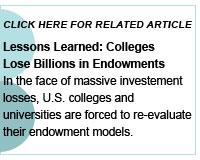When it comes to the Ivy League, the University of Pennsylvania has long operated in the shadow of Harvard and Yale. But for Kristin Gilbertson, who ran public equities and the long-short portfolios for Stanford University before moving east in 2004 to manage the Penn endowment, the financial crisis has meant a chance to outshine her better-known rivals. Penn turned in the best performance among the Ivies: Its endowment lost 15.7 percent for the year ended June 30, 2009. Yale’s fell 24.6 percent in the same period; Harvard’s suffered a 27.3 percent decline.
Penn’s performance was no accident. Gilbertson made tactical investment decisions that helped guard her school’s $5.7 billion portfolio against catastrophic losses. When she was hired as CIO, Penn had less than 10 percent of its assets in private equity, real estate and natural resources. Gilbertson was charged with building out a diversified portfolio, which would include a much larger allocation to alternatives, but she chose to go slowly because she felt valuations were sky-high. “People say you can’t time private equity and real estate,” she notes. “But we made a conscious decision to avoid racing to play catch-up.”
Gilbertson, a fan of investor Jeremy Grantham, who predicted many of the problems of 2008, moved a significant portion of Penn’s portfolio away from value-style equities into high-quality stocks that performed better in the crisis. She also reduced the equity allocation by 10 percentage points in the second quarter of 2008, to 45 percent.
“That was painful to do when the S&P 500 was at 1360, but it was a great move,” she says.

In fact, though Gilbertson wants to scale back Penn’s allocation to Treasuries, she is keeping it at 10 percent so that she can have three years of endowment payouts on hand if the economy continues to be lackluster. Penn has 18 percent in unfunded commitments to hedge funds, private equity, natural resources and real estate, which Gilbertson believes will be among the best performers in the next five years because valuations are so low.
Penn’s success is partly a by-product of the school’s unique history. Penn had little reason to adopt the endowment model favored by Yale and other Ivies; it was making fabulous returns under legendary investor John Neff, a graduate of Penn’s Wharton School who ran the Vanguard Windsor Fund for 31 years. Neff, a trustee, managed the equity portion of the endowment pari passu with the Windsor Fund, which gained more than 10 percent a year during his tenure.
In 1998, as the equity market bubble was nearing its peak and Neff wanted to retire, the trustees set up an investment office and started making some changes. Penn made its first investments in hedge funds, but its trustees were uncomfortable with copying the Yale model exactly.
“The endowment model is about absolute return, being contrarian, being flexible to pursue new opportunities when they emerge and daring to do things that others aren’t doing,” Gilbertson says.
The University of Pennsylvania is losing no time in using its relative financial strength to ramp up the competition with its peers. Even as her cash-strapped Ivy League brethren are laying off staff, Penn president Amy Gutmann is busy hiring and expanding. Her school also is making good on commitments to help students from lower-income families, she says. In a letter to the university community this summer, she wrote that the university will for the first time offer grants rather than loans and that students from families making $90,000 or less will pay no tuition or fees.






